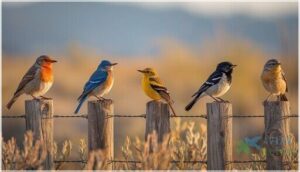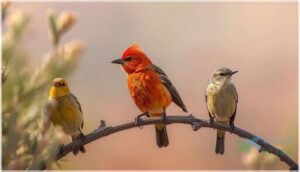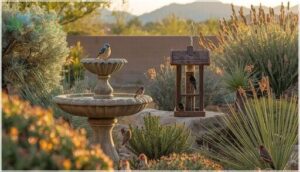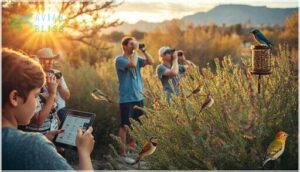This site is supported by our readers. We may earn a commission, at no cost to you, if you purchase through links.
Nevada’s backyard birds don’t wait for permission to show up. A black-chinned hummingbird hovers at your kitchen window at dawn, house finches squabble over feeder perches by mid-morning, and a Cooper’s hawk might swoop through your yard chasing prey before lunch.
The Silver State’s unique position—where Mojave Desert meets Great Basin, where elevation shifts from valley floors to mountain forests—creates a staging ground for an unexpected mix of species. Your feeders attract mountain chickadees one week and Gambel’s quail the next.
Learning to identify these visitors, understanding what brings them to your space, and creating habitat they’ll return to transforms your yard from a pit stop into a destination.
Table Of Contents
- Key Takeaways
- Common Backyard Birds of Nevada
- Identifying Nevada’s Backyard Birds
- Bird Feeding Preferences and Feeder Types
- Creating a Bird-Friendly Nevada Yard
- Supporting Bird Conservation and Community Science
- Frequently Asked Questions (FAQs)
- How do I identify a bird in my backyard?
- What birds live in the Nevada desert?
- What is killing birds in my backyard?
- What bird is Nevada known for?
- What is the most common bird in Nevada?
- How can I identify a bird in my yard?
- What is the most common backyard bird?
- What kind of birds does Nevada have?
- Is it good to have birds in your yard?
- Where have all the backyard birds gone?
- Conclusion
Key Takeaways
- Nevada’s unique geography—where Mojave Desert meets Great Basin—creates diverse backyard habitats that attract everything from black-chinned hummingbirds and house finches to Cooper’s hawks and mountain chickadees, making your yard a potential hotspot for surprising species diversity.
- Bird identification gets easier when you focus on practical field marks like color patterns, beak shapes, wing bars, and behavioral clues such as foraging zones and flight styles, rather than waiting for perfect views or memorizing hundreds of plumage details.
- Creating a bird-friendly Nevada yard requires strategic choices—native drought-tolerant plants for food and shelter, shallow water sources under 1 inch deep, properly spaced feeders 10-15 feet from windows, and clean maintenance every 1-2 weeks to prevent disease.
- Your backyard observations become conservation data when you share sightings through citizen science platforms like eBird or Project FeederWatch, turning casual birding into actionable information that helps scientists track population trends and protect habitats statewide.
Common Backyard Birds of Nevada
Your Nevada backyard can become a haven for some seriously cool birds if you know what to look for. From tiny hummingbirds zipping around your flowers to bold hawks circling overhead, the Silver State offers a surprising variety of species right outside your door.
Let’s break down the most common backyard birds you’ll spot in Nevada neighborhoods, organized by type so you can start identifying your feathered visitors today.
Songbirds Frequently Seen in Yards
Songbirds fill Nevada yards with life year-round, especially when you’ve got the right setup. House finches (Haemorhous mexicanus) flock to seed feeders, while American robins (Turdus migratorius) hunt lawns during songbird migration. Song sparrows forage near shrub edges, and black-capped chickadees visit suet stations. Western meadowlarks prefer open grassy spots.
Transform your yard habitat into songbird central:
- Offer mixed seeds at multiple bird feeders to attract diverse backyard birds
- Plant native shrubs that provide natural nesting sites and cover
- Watch for distinctive songbird behavior patterns to master bird identification
- Keep feeders clean to support healthy flocks through every season
- Add low vegetation borders where song sparrows and house finches forage safely
Understanding the importance of scientific study rigor can help in creating a more informed approach to backyard bird conservation.
Hummingbirds of Nevada Neighborhoods
Nevada’s hummingbirds bring flash and speed to your yard. Costa’s (Calypte costae) and Broad-billed species breed across desert neighborhoods, while Rufous (Selasphorus rufus) migrants pass through during spring and late summer. Anna’s hummingbird (Calypte anna) visits feeders in urban habitat zones.
Males flash bright gorgets during territorial displays, while females show duller plumage for bird identification. Feeder placement near nectar sources aids hummingbird migration and backyard birds conservation.
Effective science writing guides can help researchers communicate their findings on these species.
Doves, Sparrows, and Blackbirds in Backyards
Ground feeders rule in Nevada yards. Mourning doves (Zenaida macroura), house sparrows (Passer domesticus), and red-winged blackbirds (Agelaius phoeniceus) flock to open spaces with spilled millet and cracked corn. You’ll spot distinctive markings during breeding season:
- Doves show rosy breast washes and lean silhouettes
- Male sparrows flash black throat patches
- Blackbirds display bright shoulder badges
- Flocks probe leaf litter near water features
Yard habitat diversity attracts these species year-round.
Birds of Prey Occasionally Spotted Near Homes
Raptors bring raw drama to your yard—red-tailed hawks (Buteo jamaicensis) perch on utility poles, while Cooper’s hawks (Accipiter cooperii) ambush feeder visitors. Great horned owls (Bubo virginianus) roost in mature trees, and American kestrels (Falco sparverius) hunt roadside edges. You’ll notice backyard predators during hawk migration or suburban nesting cycles.
| Species | Hunting Behavior |
|---|---|
| Red-tailed Hawk | Glides over residential blocks |
| Cooper’s Hawk | Ambushes songbirds at feeders |
| American Kestrel | Hunts in open yard spaces |
| Great Horned Owl | Roosts near dwellings at night |
| Bald Eagle | Forages near suburban water |
Urban raptors thrive where bird feeder safety meets dense vegetation cover.
Waterbirds Seen in Urban and Suburban Areas
City ponds and parks draw surprising waterbird diversity to Nevada neighborhoods. You’ll spot mallards (Anas platyrhynchos) at street-side lagoons, double-crested cormorants (Phalacrocorax auritus) on municipal reservoirs, and American wigeons (Mareca americana) wintering on golf courses. Urban waterbirds adapt remarkably to bird-friendly cities, making backyard birding essential for wetland conservation and wildlife conservation.
- Mallards frequent urban ponds year-round, showing reduced wariness near regular human activity
- Double-crested cormorants perch on pilings at city reservoirs during fish-spawning periods
- Hooded mergansers (Lophodytes cucullatus) appear in riparian corridors near suburban streams
- Red-winged blackbirds forage along marshy edges of urban waterbird habitats during migration
- Community science reports help track urban birding patterns and bird species identification across Nevada
Identifying Nevada’s Backyard Birds
You don’t need a fancy degree to start identifying the birds that show up in your Nevada yard. Once you know what to look for—colors, patterns, size differences, and how a bird moves—you’ll recognize species faster than you’d expect.
Let’s break down the key clues that turn a quick glance into a solid identification.
Bird Identification by Color and Markings
You’ll spot most backyard birds by scanning for color markings and plumage patterns—the real bird signatures that separate House Finches from lookalikes. Focus on key features: red throat patches on Anna’s Hummingbirds, yellow rumps on Yellow-rumped Warblers, and white wing bars on Western Kingbirds. Beak colors and feather textures add extra clues for confident bird species identification.
| Feature | Example Species |
|---|---|
| Red breast patch | American Robin |
| Yellow rump | Yellow-rumped Warbler |
| Black & red wing | Red-winged Blackbird |
| Gray head, yellow belly | Western Kingbird |
| Bright blue plumage | Mountain Bluebird |
Recognizing Male, Female, and Juvenile Plumages
Plumage patterns shift with age and sex, making bird identification trickier than you’d think. Male backyard birds flash brighter colors—vibrant reds and blues—while females wear muted tones for camouflage during nesting. Juveniles show streaked, dull feathers that gradually transform through molt cycles.
In Nevada ornithology, tracking these color variations and seasonal changes sharpens your bird watching skills and helps with accurate sex determination and age identification in the field.
Distinguishing Similar Species in Your Yard
Separating lookalikes in your Nevada yard takes a sharp eye. Focus on wing bars, beak shapes, and tail feathers—visual clues that clinch IDs fast. Western Kingbirds show white edges, while Yellow-rumped Warblers flash yellow rumps.
Plumage patterns and feather colors shift with seasons, so note those molt changes. Song and call notes seal the deal when markings blur together.
Tips for Identifying Birds by Behavior
Watching how a bird moves cracks the ID code wide open. Behavioral cues reveal species faster than fleeting glimpses of feathers ever could.
Track these feeding habits and vocalization patterns:
- Foraging zones – ground feeders versus canopy hunters
- Flight styles – rapid zig-zag paths signal hummingbirds
- Alarm calls – pitch spikes near predators
- Territorial displays – wing flicks mark breeding season
- Provisioning rates – feeding frequency peaks before fledging
Nesting behaviors and migration routes add confirmation when backyard birds share similar plumage.
Bird Feeding Preferences and Feeder Types
Getting birds to show up at your feeder isn’t just about tossing out some seeds and hoping for the best. Different Nevada species have their own preferences regarding feeder styles and food choices, and matching the right setup to your local birds makes all the difference.
Here’s what works best for attracting the backyard birds you want to see.
Popular Feeders for Nevada Bird Species
Different bird feeders attract different Nevada backyard birds, and knowing which works best saves you time and money. Platform feeders welcome 92.5% of species, while large hopper feeders draw 64.8%.
Ground feeders suit doves and sparrows, tube feeders hold smaller seeds for finches, and suet feeders bring woodpeckers year-round.
Feeder placement and maintenance matter for success.
Choosing The Best Birdseed and Food Types
Once you’ve set up the right bird feeders, seed selection becomes your next move. Black-oil sunflower seeds and oil-rich safflower attract diverse seed-eating backyard birds while discouraging squirrels.
For bird nutrition in winter, offer suet options high in fat. Store birdseed in airtight containers to prevent mold, and clean feeders weekly—feeder maintenance protects your visitors from disease while keeping bird identification easier.
Attracting Hummingbirds With Feeders
Hummingbirds in Nevada deserve more than just seeds—they need liquid energy. Mix 1 part white sugar to 4 parts water for nectar recipes (skip the red dye), and swap it out every 2 to 4 days in hot weather.
Bird safety matters: clean feeders with vinegar weekly to prevent mold. Feeder placement works best at 4 to 6 feet high, near flowers but away from traffic.
Time your backyard birding with hummingbird migration—hang feeders 1 to 2 weeks before spring arrivals. You’ll attract Anna’s, Black-chinned, Calliope, Rufous, and Broad-tailed Hummingbirds with proper bird feeding practices.
Proper Placement and Maintenance of Feeders
Beyond nectar recipes, feeder placement and bird safety go hand-in-hand. Position bird feeders 10 to 15 feet from windows to prevent collisions, and mount them 5 to 6 feet high for predator control.
Feeder cleaning with vinegar every two weeks stops disease spread among backyard feeder birds. Seasonal maintenance includes checking hardware monthly and rotating birdseed types to keep Nevada’s birdfeeders effective year-round.
Creating a Bird-Friendly Nevada Yard
Turning your Nevada yard into a haven for birds doesn’t require a complete makeover—just a few thoughtful changes can make all the difference.
The desert environment presents unique challenges, but with the right approach, you’ll create a space where birds feel safe, find food, and return season after season.
Here’s how to transform your outdoor space into a welcoming habitat that local birds can’t resist.
Planting Native Plants for Food and Shelter
Native plant selection transforms your yard into a year-round haven for Nevada’s birds. Drought-tolerant species like bunchgrasses and desert willows create water-wise gardening solutions while supporting habitat restoration. You’ll attract more species with bird-friendly landscaping that layers trees, shrubs, and groundcover—this structural diversity offers nesting sites and foraging zones. Wildlife-friendly landscaping anchors gardening for wildlife success across seasons.
- Native plants provide seeds, berries, and insect prey throughout Nevada’s challenging climate
- Dense shrubs offer protected nesting cavities for small songbirds
- Flowering sequences support hummingbirds and seed-eating species year-round
Wildlife-friendly landscaping ensures gardening for wildlife success throughout the year.
Providing Water Sources for Birds
Water quality matters just as much as availability when you’re setting up bird baths for Nevada’s backyard birds. Keep water depth under 1 inch in shallow ponds and dishes—deeper water risks drowning smaller species.
Add fountain features occasionally to create movement that attracts warblers and hummingbirds.
Clean containers weekly to prevent disease while supporting wildlife and ecology through birdfriendly plants and native plants nearby.
Installing Birdhouses and Nesting Sites
Nesting box designs turn your Nevada yard into a breeding hotspot for bluebirds and kestrels. Mount boxes 5–12 feet high with predator control baffles on poles, facing away from harsh winter winds.
- Install 1.5-inch entrance holes for mountain bluebirds and 3.25-inch openings for American kestrels
- Space boxes 20–30 meters apart to prevent territorial squabbles
- Clean annually before spring breeding season for proper nesting site maintenance
This box installation approach fosters backyard birding in Nevada.
Reducing Hazards and Promoting Safety
Window collisions kill millions of backyard birds annually—Nevada yards aren’t exempt. Apply bird window films or decals spaced 2–4 inches apart to break reflections.
Install cat deterrents like motion-activated sprinklers and safety nets around vulnerable feeding zones. Remove hazard items such as nylon netting and exposed wires.
These wildlife-friendly landscaping adjustments support bird conservation and boost your wildlife conservation efforts statewide.
Supporting Bird Conservation and Community Science
Watching birds in your backyard connects you to something bigger than your own slice of Nevada sky. Your observations can help scientists track populations, protect habitats, and understand how birds are adapting to change.
Backyard birding transforms casual observation into meaningful conservation, connecting your Nevada yard to scientific efforts that track populations and protect habitats
Here’s how you can join the effort and make your birding count for conservation.
Participating in Local Bird Counts and Projects
You can make a real difference by joining citizen science projects that track Nevada’s backyard birds. The National Audubon Society’s Christmas Bird Count and Cornell Lab’s eBird let you submit sightings with date, time, and location.
Project FeederWatch collects winter data, while local nature centers host bird surveys.
Your observations fuel conservation efforts and help scientists monitor population trends across the state.
Reducing Pesticide Use and Protecting Habitats
Your yard becomes a haven when you ditch the chemicals. Pesticide Free Landscapes in Nevada support Backyard Birds by attracting natural pest controllers and boosting pollinator diversity. Native Plant Benefits include reduced need for sprays while providing essential food and shelter.
Focus on Habitat Restoration through Eco Friendly Gardening—layered vegetation and buffer zones protect Bird Habitats and advance Wildlife Conservation and Environmental Conservation efforts statewide.
Joining Nevada Birding Groups and Clubs
You’ll access amazing Club Membership Benefits and Volunteer Opportunities by joining Nevada Bird Watching communities. Local birding groups offer Birding Event Planning like field trips, workshops, and Bird Watching Tours that strengthen Community Engagement.
These Birding Communities coordinate Conservation Efforts through habitat projects and citizen science, transforming your Backyard Birding into meaningful action for Nevada birds.
Sharing Sightings for Conservation Efforts
Your backyard observations become powerful conservation tools when you share them through Citizen Science platforms. Submit bird sightings with species, date, and location—Data Validation through photo verification keeps records accurate.
This Species Tracking aids Habitat Preservation by revealing migration patterns and population trends.
Nevada Bird Watching communities use your Bird Identification reports to inform Wildlife Conservation decisions, turning casual Backyard Birding into Conservation Outcomes that protect birds statewide.
Frequently Asked Questions (FAQs)
How do I identify a bird in my backyard?
Start with size—compare it to a sparrow or robin. Then check the beak shape, wing bars, and tail feather color.
Note feeding behavior and habitat, which help narrow down your bird species quickly.
What birds live in the Nevada desert?
In wild country, the land shapes its creatures—Nevada’s desert birdlife thrives where sun meets sand.
Greater Roadrunners dash across open ground, Gambel’s Quail forage in desert-scrub, and Canyon Wrens echo through rocky canyons.
What is killing birds in my backyard?
Multiple threats put Nevada’s feeder visitors at risk: domestic cats kill billions of birds annually, window collisions cause major mortality, pesticides poison non-target species, and diseases spread at contaminated feeders.
What bird is Nevada known for?
Nevada’s state emblem is the Mountain Bluebird (Sialia currucoides), an iconic species sporting vivid azure plumage.
You’ll spot these desert habitats specialists in sagebrush country, where they hunt insects from exposed perches year-round.
What is the most common bird in Nevada?
House sparrows hold the crown in cities and towns, thriving thanks to their tenacious ability to nest near people.
Rural regions reveal mourning doves dominating desert edges and open fields year-round.
How can I identify a bird in my yard?
Start with the bird’s size and overall shape, then check beak type and feather patterns.
Notice wing bars, tail features, and flight styles—these visual cues help you nail down species quickly.
What is the most common backyard bird?
Like a friendly neighbor who never misses coffee hour, the house sparrow (Passer domesticus) shows up most often in Nevada backyards, thriving in urban habitats where bird feeders and human activity create perfect opportunities for this adaptable species.
What kind of birds does Nevada have?
You’ll spot everything from Desert Birds like quail and hummingbirds to Migratory Birds such as warblers.
Nevada Bird Species range from Urban Birds in cities to Woodland Birds of Nevada in riparian zones.
Is it good to have birds in your yard?
Yes—backyard birds boost biodiversity, control insects, and pollinate plants. Birdwatching reduces stress and connects you to urban wildlife. Regular observations support ecosystem health monitoring and conservation efforts across Nevada’s neighborhoods.
Where have all the backyard birds gone?
Habitat loss, climate shifts, and urban planning changes have reduced insect and water availability across Nevada.
Conservation efforts like native plantings and pesticide reduction help restore yards for declining backyard birds.
Conclusion
Some claim backyard birds choose yards randomly—windblown vagrants with no pattern. Watch closer. The truth reveals intention: backyard birds of Nevada return where water flows, native plants seed, and perches offer safety.
Your yard becomes their calculated choice when you meet their needs. Set out feeders, plant desert willow, keep a birdbath clean. They’ll find you, claim the space, and teach you that wild things don’t need permission—just the right invitation.











